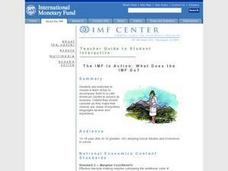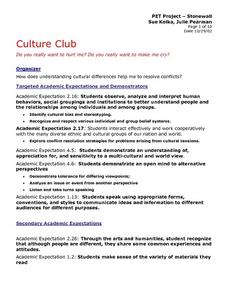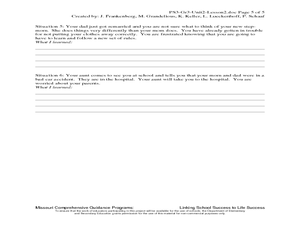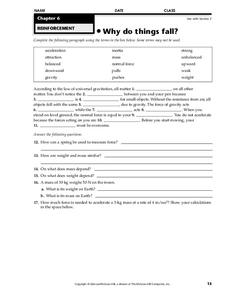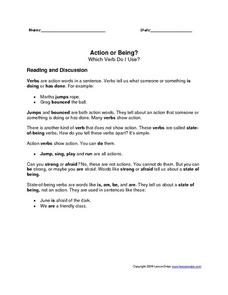Curated OER
ESL Things We Like To Do Multiple Choice Worksheet
In this ESL things we like to do multiple choice worksheet, students answer 8 questions based on clip art pictures. They choose the correct answer from 4 that best answers the questions which include, "Can Kermit play tennis?" and "Do...
Curated OER
From the Farm to Your Table: Where Does Our Food Come From?
Learners discover where the food they eat comes from. Using maps, they identify the agricultural areas of the United States and the products that are grown in each area. Using the internet, they research how food gets to America from...
Intel
What Does This Graph Tell You?
Learners choose natural phenomena to research. They design and conduct experiments or simulations. Students predict, gather, and analyze data. They graph the results using a spreadsheet software.
Curated OER
Auxiliary Verbs (To Be, To Do, To Have) 1
In this auxiliary verbs (to be, to do, to have) worksheet, students fill in ten blanks in ten sentences with the correct auxiliary verb to make each one grammatically correct.
Curated OER
Drill - Sentences with 'do'
In this grammar worksheet, learners rewrite fifteen sentences using the action verb be. Students study the example given for each category of sentences.
Curated OER
The IMF in Action: What Does the IMF Do?
Students use newspapers and the internet to discover what the IMF does. They work together in groups to brainstorm occupations which need another language to be spoken. They also examine data related to trading among countries.
Curated OER
The Earth is Tilted, What Does that Mean?
Middle schoolers examine the tilt in the Earth's revolution around the sun. Using that information, they draw a picture and label the indirect and direct rays of the sun. In groups, they answer discussion questions and complete an...
Curated OER
Using Symbols to Subtract
In this mathematics worksheet, 1st graders use symbols to subtract. They identify various symbols used when subtracting and explain why they may be used.
Curated OER
Culture Club Do You Really Want To Hurt Me? Do You Really Want To Make Me Cry?
Fourth graders investigate cultural differences and determine how this knowledge will help resolve conflicts. They look at how the history of Kentucky was influenced by Native Americans. They design a conflict resolution presentation...
Curated OER
How Does our Heart Rate Change?
Students feel their pulse and describe it. They predict whether certain activities will increase or decrease their heart rates. Students use a heart rate sensor to determine resting heart rates and those after activity. In conclusion,...
Curated OER
Using Decimals and Fractions to Count Classmates
In this using decimals and fractions to count classmates worksheet, 5th graders use data from classmates to figure out decimal and fraction ratios.
Curated OER
Comparing and Contrasting Fiction and Nonfiction Using Graphic Organizers
Learners compare and contrast fiction and non-fiction selections. In this writing skills lesson, students use different forms of graphic organizers to compare "The Three Little Pigs," to Wiesel's Night.
Curated OER
Use Negative Numbers
In this problem solving worksheet, students read and solve 6 story problems pertaining to borrowing and paying back money. Students use instead simple subtraction and addition. No answers will be negative numbers.
Curated OER
What to do? What to do? Part Two
Third graders perform skits and note ideas fro problem solving in various situations. In this coping lesson, 3rd graders role play problem solving and coping in life-changing situations based on "What to Do" solution starters.
Curated OER
Conversation Exercises: "So Do I" or "Neither Do I"
In this online conversation exercise worksheet, learners read how to use "So do I!" and "Neither do I!" They complete complete 8 sentences by listening to the sentences and responding. They choose the correct response in each of 12...
Curated OER
Reading a Chart: When Does School Start Where You Live?
In this chart reading instructional activity, 3rd graders will read data about when different countries start school during the year. They will then use the chart to answer a variety of multiple choice and short answer questions.
Curated OER
Why Do Things Fall?
For this science worksheet, students complete a paragraph using 15 given terms. For example, "How can a spring be used to measure force?"
Curated OER
What Difference Does A Name Make?
Students view the film The Persuaders that discuss the perspective and spin of language use for a variety of issues. They discuss the career of Frank Luntz, a man that runs focus groups to determine how to advantageously phrase issues in...
Curated OER
Does the Distance Between the Earth and Sun Cause the seasons?
Young scholars reflect upon the concepts of seasons. The concepts are taught using a variety of different teaching approaches. A activities lead to a reflection that will help students to make a cognitive transfer of information form...
Curated OER
Where is Your Heart? What Does it Do?
Students identify size and general location of human heart, identify heart muscle, describe, in general terms, heart's basic function of pumping blood throughout body, and complete "Where is Your Heart" and "What Does My Heart Look...
Curated OER
ESL What Do They Do? Multiple Choice Worksheet
In this ESL jobs multiple choice worksheet, learners look at 8 pictures to determine what people are doing. They pick the best answer to complete a statement that tells what a person does such as, "A fisherman is a person who...."
Curated OER
Problem Solving: Strategy: Use Logical Reasoning
In this problem solving strategy instructional activity, 6th graders solve a story problem using the strategies of understand, plan, solve, and look back.
Curated OER
How Does the Moon Affect Tidal Range?
Eighth graders study the phases of the moon. For this tides lesson students use the Internet to retrieve information.
Curated OER
Action or Being?--Which Verb Do I Use?
In this verbs worksheet, students read and determine if the verbs in 7 sentences are action or state-of-being verbs and write the 4 state-of-being and action verbs learned on the lines provided. Students underline the verbs in 8...





